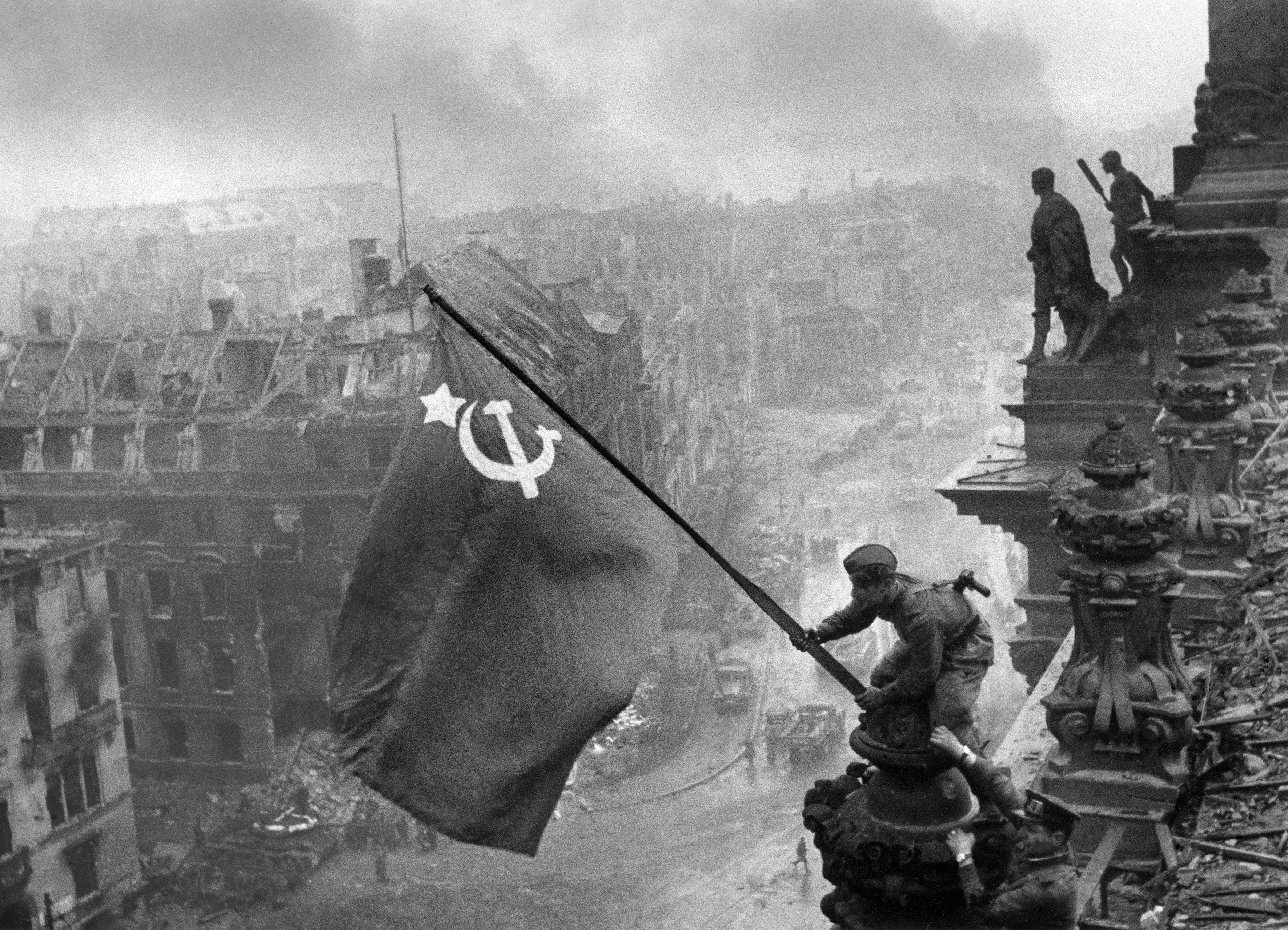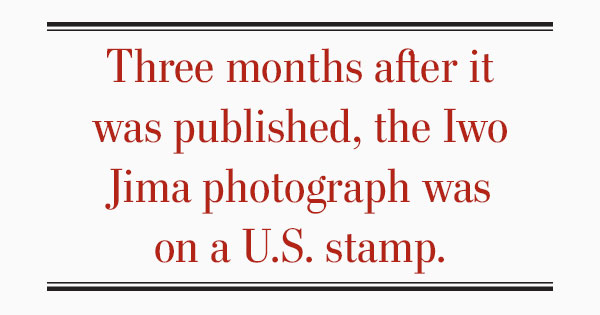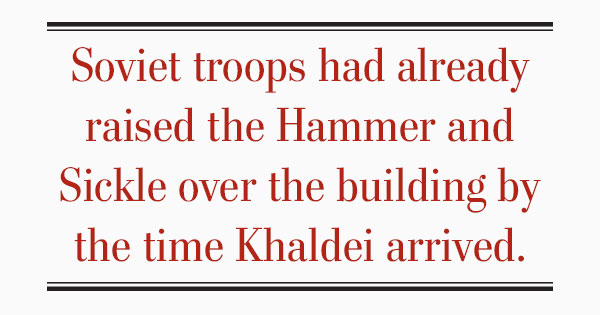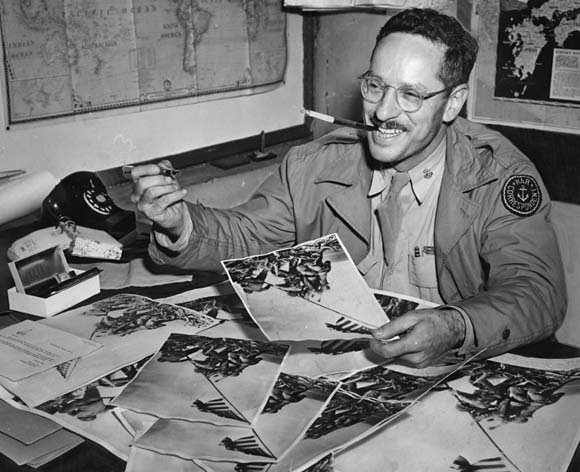

(TOP) Marines raise the American flag atop Mount Suribachi during the battle on Iwo Jima on Feb. 23, 1945. The image by Joe Rosenthal of the day’s second flag-raising is among the most iconic in the history of war, yet it has been the subject of false allegations that it was a set-up. (ABOVE) Soviet soldiers raise the flag on the roof of the Reichstag in Berlin in May 1945. The photograph was made to order for the Kremlin, which dispatched photographer Yevgeny Khaldei to provide something to rival Rosenthal’s Raising the Flag On Iwo Jima. [Library of Congress/AP-Joe Rosenthal; Yevgeny Khaldei]
Raising the Flag on Iwo Jima by Joe Rosenthal and Soviet Flag over the Reichstag by Yevgeny Khaldei are two of the most iconic photographs of the Second World War.
But their genesis and their evolution in the archive of immortal photographs have taken a long and circuitous route through history.
Rosenthal was an Associated Press photographer attached to the U.S. Marines in the Pacific, most notably during the bloody 36-day battle for the Japanese-held island of Iwo Jima in February and March of 1945.
His photograph of marines raising the Stars and Stripes on Mount Suribachi became one of the most revered and debated war photographs in history, the central theme of the Americans’ most successful war bond drive and the subject of revelation to this day.
Khaldei was a Red Army officer and a photographer for the Tass news agency who was dispatched by the Kremlin—possibly by Stalin himself—in May 1945 to match the impact of Rosenthal’s photograph with an image symbolizing the Soviet triumph over Nazi tyranny.
Like Rosenthal, Khaldei was Jewish, a battle-hardened photojournalist (and propagandist) who carried a weapon, likely used it, and had ripped the yellow Star of David from the chests of Hungarian Jews as he photographed their liberation in Budapest.

Rosenthal’s photograph, along with three of the purported flag-raisers who survived the battle (three others died), propelled the Seventh U.S. War Bond Drive in April 1945. Its goal: to raise $14 billion. It realized a whopping $26.3 billion in 38 days—almost half the 1946 U.S. federal budget of $56 billion.
That $26.3 billion in 1945 dollars translates to $364.6 billion in 2018, according to the online Inflation Calculator. Three months after it was published, the Iwo Jima photograph was on a U.S. stamp.
Yet Rosenthal’s picture—reproduced in posters hung in countless homes and public places, the basis of the Marine Corps War Memorial in Arlington, Va., and imprinted in the hearts and minds of millions of Americans—was for decades denigrated as a set-up when, in fact, it wasn’t.
Rosenthal’s near-perfect photograph was taken a half-century before high-volume digital cameras dulled an Internet-savvy public to its kind of symmetry and impact. It was one shot taken in the midst of the marines’ bloodiest battle of the war.
Rosenthal only shot 60 pictures on Iwo Jima and, in testament to his photographic skills, half of them made the grade, going out to the world on AP’s wire network.
The controversy swelled around the fact his Mount Suribachi picture depicted the second flag-raising on Iwo Jima. When the false set-up narrative took hold, few people knew that the second flag had been ordered by a U.S. admiral in the fleet offshore after he deemed the first one too small.

Marine Sergeant Louis Lowery’s picture of the first flag-raising on Iwo Jima for Leatherneck Magazine. A second flag was ordered by a U.S. admiral after he deemed that the original stars and stripes was too small. [Leatherneck Magazine/Louis Lowery]
“Hey, you’re late fellas, there’s already a flag up there,” Lowery told Rosenthal. Yet he encouraged the AP man to continue his climb, just to take in the awesome vista as the battle raged below.
Reaching the summit, the three shooters spotted a group of marines holding a second flag. Rosenthal had been given a reprieve.
“Here the ground sloped down toward the center of the volcanic crater, and I found that the ground line was in my way,” Rosenthal later recalled.
“I put my Speed Graphic down and quickly piled up some stones and a Jap sandbag to raise me about two feet (I am only 5 feet 5 inches tall) and I picked up the camera and climbed up on the pile. I decided on a lens setting between f/8 and f/11, and set the speed at 1/400 of a second.
“At this point, 1st Lieutenant Harold G. Shrier…stepped between me and the men getting ready to raise the flag. When he moved away, Genaust came across in front of me with his movie camera and then took a position about three feet to my right. ‘I’m not in your way, Joe?’ he called.
“’No,’ I shouted, ‘and there it goes.’
“Out of the corner of my eye, as I had turned toward Genaust, I had seen the men start the flag up. I swung my camera, and shot the scene.”
Rosenthal had not even raised the bulky news camera to his eye before he took the epic photograph. AP transmitted the picture on March 7, 13 days after it had been taken—fast by the standards of the time. It fronted newspapers worldwide.

Khaldei could not find a Soviet flag in chaotic Berlin. He returned to Moscow where his uncle, a tailor, gave him a flag he had hand-sewn from three tablecloths—big enough to do the job. Back in Berlin, the photographer considered locations, including the Brandenburg Gate and Tempelhof Airport.
He settled on the Reichstag, the 50-year-old former site of the German parliament. It had been damaged by fire early in the Nazis’ rise to power and fell into disuse, but it nevertheless held great symbolism.
Soviet troops had already raised the Hammer and Sickle over the building by the time Khaldei arrived. Undeterred, he rounded up a few soldiers and, on May 2, 1945, set out to recreate the scene.

Joe Rosenthal won the Pulitzer Prize and international acclaim for his photograph of the flag-raising on Iwo Jima. [AP]
When the photograph reached Moscow, Soviet censors noted that Ismailov was wearing a watch on each wrist, raising suspicions he had pulled them from dead soldiers. It would later be asserted that the extra wristband actually held an Adrianov military compass.
Regardless, Khaldei was asked to remove one of the accoutrements, lest people think the worst. The photographer complied. He also added clouds and smoke to increase the dramatic effect.
The Soviet magazine Ogonjok published the manipulated photograph and the version soon gained worldwide exposure.
“This is what I was waiting for for fourteen hundred days,” Khaldei said later. “It was scary but I was euphoric, so I didn’t notice.”
While Photoshop manipulations have garnered much attention in the digital age, such doctoring was not uncommon in photography’s earlier days, especially in the fog of war.
Robert Capa’s famous 1936 photograph, The Falling Soldier, purportedly depicting the death of a Republican during the Spanish Civil War, has been deemed a likely set-up. Its merits are still hotly debated among photographic historians and others.
Many, if not most, battlefield-action photographs and films taken during the First World War were actually staged, some taken during exercises.
In a time when slow cameras couldn’t freeze much movement, renowned U.S. Civil War photographer Matthew Brady was known to have manipulated images, most of them unprecedented photographs of war dead on American battlefields.
Khaldei’s scene on the Reichstag rooftop was described in his 1997 obituary in The New York Times as “almost operatic in its effect.” It was reproduced in magazines around the world and, like Rosenthal’s photo in America, became a staple of Soviet postage stamps and commemorative postcards.
Throughout his life, Khaldei was steadfast in his deception. Whenever asked, he responded: “It is a good photograph and historically significant. Next question please.”
“Khaldei saw himself as a propagandist for a just cause, the war against Hitler and the German invaders of his homeland,” the German magazine Der Spiegel wrote. “In the years before his death in October 1997 he liked to say: ‘I forgive the Germans, but I cannot forget.’ His father and three of his four sisters were murdered by the Germans.”

Photographer Yevgeny Khaldei covers the 1946 trial of Hermann Göring at the Nuremberg Trials. [Wikimedia]
But it was the allegations of a set-up that plagued Rosenthal most.
Embittered by Rosenthal’s success at the expense of his own photograph, and likely unaware that the second flag had been ordered by senior command, Lowery, the Leatherneck Magazine shooter, asserted early on that the image must have been staged.
Genaust, the film cameraman, had been killed in action, so he wasn’t around to defend Rosenthal. His footage ultimately would prove the picture was the real deal.
Military officials and editors from Life magazine and AP eventually met and put the controversy to rest, though many in the public realm remained unconvinced. Rosenthal would spend the rest of his days defending his most famous photograph.
Before he died in 2006 at age 94, Rosenthal told Hal Buell, former executive news photo editor at The Associated Press, that he never got over the controversy and the repeated accusations that he had staged the picture. He was angry.
Rosenthal and Lowery eventually settled their differences. They reunited years later in a hotel room at a Marine event in the Carolinas and shared a bottle of bourbon. Afterward, Lowery acknowledged Rosenthal’s picture was not posed.
“He said it was an honest-to-God picture and they remained friends,” Buell said. “In fact, Joe attended Lou Lowery’s funeral when he died.”
Buell described Raising the Flag on Iwo Jima as an “exquisite” photograph. “You have this strong, diagonal line made by the flagstaff,” he told CNN in 2016. “You have the flag snapping in the breeze. You have the pyramid-like shape of the Marines pushing the flag up. The men obviously are separate, but they appear as one. The blank background enhances the action by providing no distractions.
“Also, the photo is gifted with a softly filtered light. A very thin haze of clouds filters the light so that the shadows aren’t harsh, but there is detail in all the shadows on the uniforms and the flag.”
High art, in the ugly times of war.
Advertisement





















